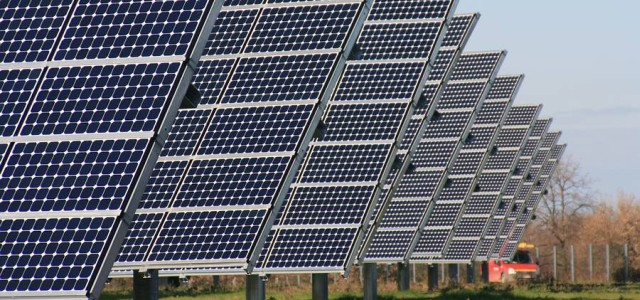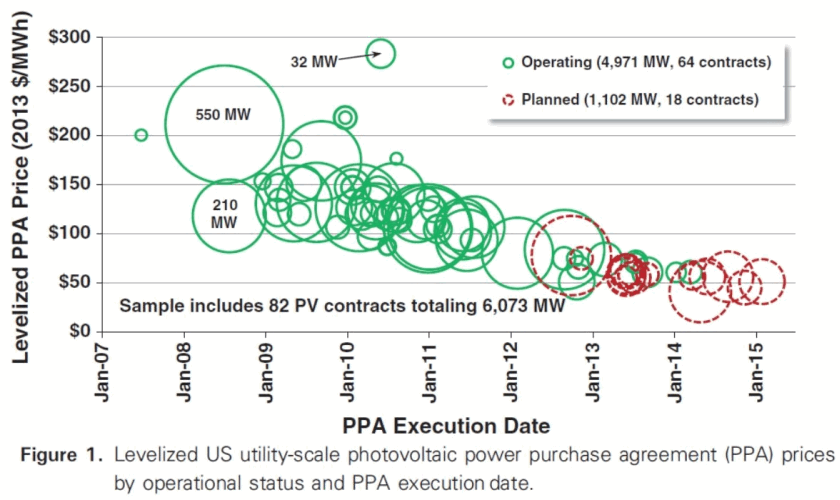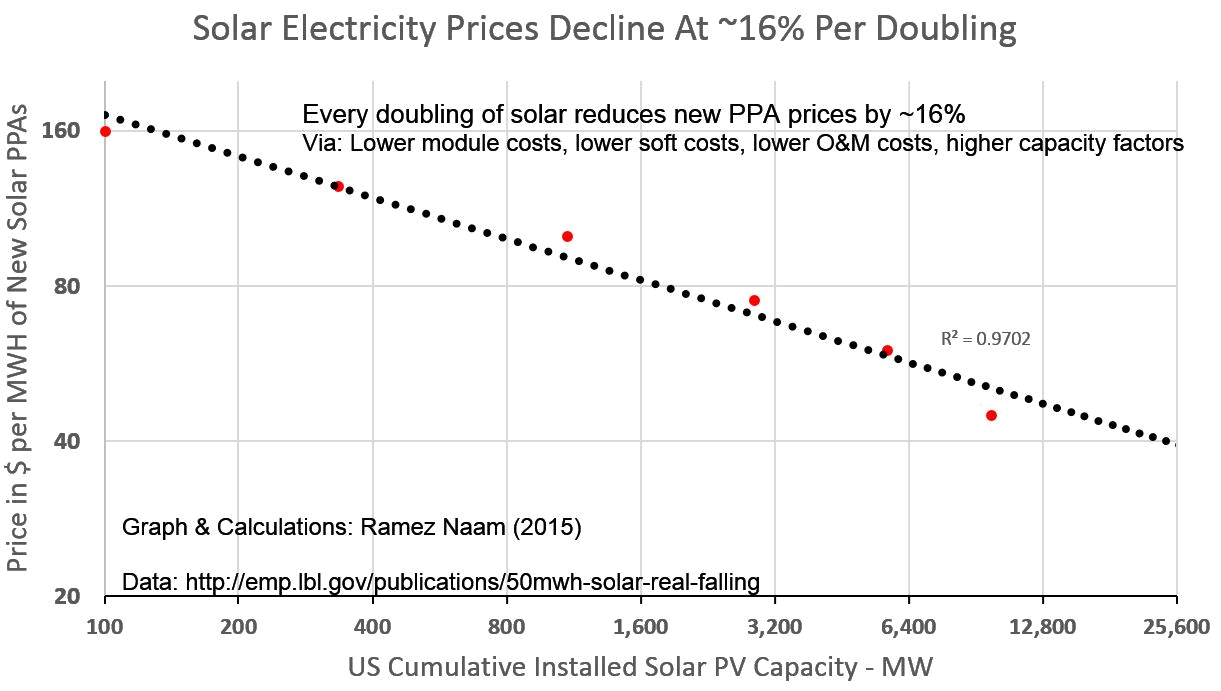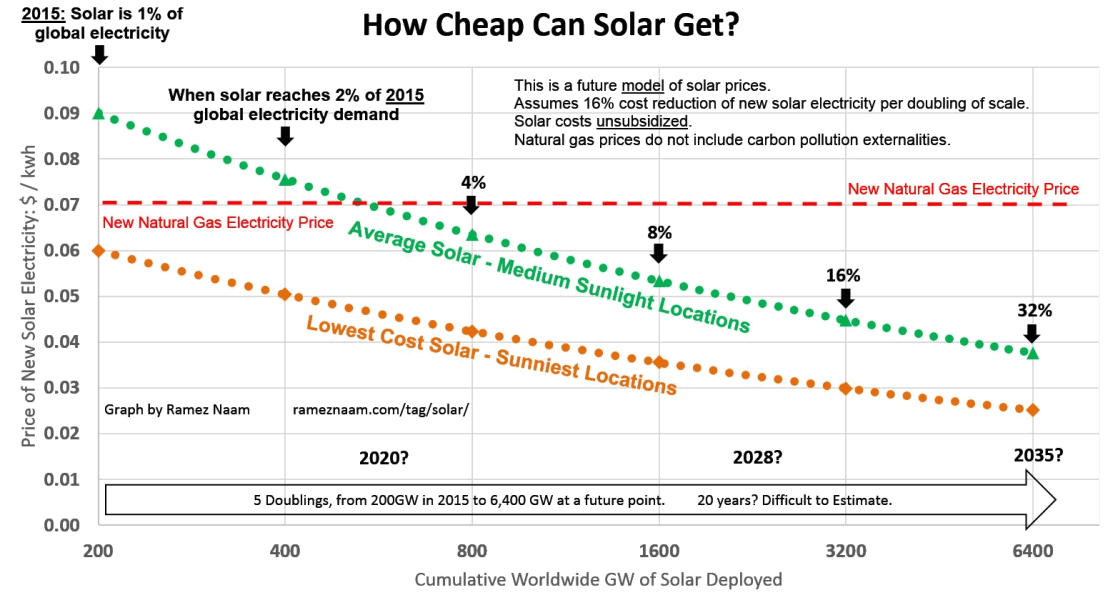If current rates of improvement hold, solar power will be incredibly cheap in just a few years’ time, writes famous author and thinker Ramez Naam. According to Naam, electricity cost is from now on coupled to the ever-decreasing price of technology. That is profoundly deflationary and disruptive.

Solar power is getting cheaper every day – and that’s good news for the planet and people. (Photo by Jchantraine, CC BY-SA 3.0)
Background: The Exponential Decline in Solar Module Costs
It’s now fairly common knowledge that the cost of solar modules is dropping exponentially. I helped publicize that fact in a 2011 Scientific American blog post asking “Does Moore’s Law Apply to Solar Cells?” The answer is that something like Moore’s law, an exponential learning curve (albeit slower than in computing) applies. (For those that think Moore’s Law is a terrible analogy, here’s my post on why Moore’s Law is an excellent analogy for solar.)
Solar Electricity Cost, not Solar Module Cost, is Key
But module prices now make up less than half of the price of complete solar deployments at the utility scale. The bulk of the price of solar is so-called “soft costs” – the DC->AC inverter, the labor to install the panels, the glass and aluminum used to cover and prop them up, the interconnection to the grid, etc.. Solar module costs are now just one component in a more important question: What’s the trend in cost reduction of solar electricity? And what does that predict for the future?
Let’s look at some data. Here are cost of solar Power Purchase Agreements (PPAs) signed in the US over the last several years. PPAs are contracts to sell electricity, in this case from solar photovoltaic plants, at a pre-determined price. Most utility-scale solar installations happen with a PPA.
In the US, the price embedded in solar PPAs has dropped over the last 7-8 years from around $200 / MWh (or 20 cents / kwh) to a low of around $40 / MWh (or 4 cents per kwh).

The chart and data are from an excellent Lawrence Berkeley National Labs study, Is $50/MWh Solar for Real? Falling Project Prices and Rising Capacity Factors Drive Utility-Scale PV Toward Economic Competitiveness
This chart depicts a trend in time. The other way to look at this is by looking at the price of solar electricity vs how much has been installed. That’s a “learning rate” view, which draws on the observation that in industry after industry, each doubling of cumulative capacity tends to reduce prices by a predictable rate. In solar PV modules, the learning rate appears to be about 20%. In solar electricity generated from whole systems, we get the below:

This is a ~16% learning rate, meaning that every doubling of utility-scale solar capacity in the US leads to a roughly 16% reduction in the cost of electricity from new solar installations. If anything, the rate in recent years appears to be faster than 16%, but we’ll use 16% as an estimate of the long term rate.
Every Industrial Product & Activity Gets Cheap
This phenomenon of lower prices as an industry scales is hardly unique to solar. For instance, here’s a view of the price of the Ford Model T as production scaled.

Like solar electricity (and a host of other products and activities), the Model T shows a steady decline in price (on a log scale) as manufacturing increased (also on a log scale).
The Future of Solar Prices – If Trends Hold
The most important, question, for solar, is what will future prices be? Any projection here has to be seen as just that – a projection. Not reality. History is filled with trends that reached their natural limits and stalled. Learning rates are a crude way to model the complexities involved in lowering costs. Things could deviate substantially from this trendline.
That said, if the trend in solar pricing holds, here’s what it shows for future solar prices, without subsidies, as a function of scale.

Again, these are unsubsidized prices, ranging from solar in extremely sunny areas (the gold line) to solar in more typical locations in the US, China, India, and Southern Europe (the green line).
What this graph shows is that, if solar electricity continues its current learning rate, by the time solar capacity triples to 600GW (by 2020 or 2021, as a rough estimate), we should see unsubsidized solar prices of roughly 4.5 c / kwh for very sunny places (the US southwest, the Middle East, Australia, parts of India, parts of Latin America), ranging up to 6.5 c / kwh for more moderately sunny areas (almost all of India, large swaths of the US and China, southern and central Europe, almost all of Latin America).
And beyond that, by the time solar scale has doubled 4 more times, to the equivalent of 16% of today’s electricity demand (and somewhat less of future demand), we should see solar at 3 cents per kwh in the sunniest areas, and 4.5 cents per kwh in moderately sunny areas.
If this holds, solar will cost less than half what new coal or natural gas electricity cost, even without factoring in the cost of air pollution and carbon pollution emitted by fossil fuel power plants.
As crazy as this projection sounds, it’s not unique. IEA, in one of its scenarios, projects 4 cent per kwh solar by mid century. Fraunhofer ISE goes farther, predicting solar as cheap as 2 euro cents per kwh in the sunniest parts of Europe by 2050.
Obviously, quite a bit can happen between now and then. But the meta-observation is this: Electricity cost is now coupled to the ever-decreasing price of technology. That is profoundly deflationary. It’s profoundly disruptive to other electricity-generating technologies and businesses. And it’s good news for both people and the planet.
This article was first published in the blog section of Ramez Naam’s website on 10 August and is republished here with permission from the author. He is also looking at the future prospects of wind, of energy storage, and, finally, at what parts of the decarbonization puzzle are missing, on his blog.
Ramez Naam is an award-winning writer of non-fiction and science fiction, a speaker and entrepreneur. He spent 13 years at Microsoft, where he led teams developing early versions of Microsoft Outlook, Internet Explorer, and the Bing search engine. His career has focused on bringing advanced collaboration, communication, and information retrieval capabilities to roughly one billion people around the world, and took him to the role of Partner and Director of Program Management within Microsoft.
Cheapest power to create cheapest power:
http://www.pv-magazine.com/news/details/beitrag/silicor-raises-us105-million-to-support-umg-polysilicon-in-iceland_100021104/#axzz3m2Agk38h
In the USA Solarworld is co-operating with Enerphase (plug-and-play):
http://www.pv-tech.org/news/solarworld_enphase_to_collaborate_on_new_ac_modules
Breaking news:
The Belgian power price shot up today to €448.-/MWh due to the failure of the atomic power plants:
http://www.gva.be/cnt/dmf20150922_01879999/stroomprijs-bereikt-ongekende-hoogtes-door-problemen-tihange
The supply situation is very critical, brown-outs are in preparation:
http://www.gva.be/cnt/dmf20150922_01880169/nijpende-situatie-op-elektriciteitsmarkt
The reserves are up and running:
http://www.standaard.be/cnt/dmf20150922_01880165
Feared at the moment is “Murphy’s law”, if anything else comes up the grid will collapse.
Blamed is not only the failure of the atomic power plants but a low wind and PV harvest today, grid improvement works and gas power plant preparations (outages) for the coming winter time.
Keep an eye on the actual news coming via the international media.
http://www.elia.be/en/grid-data/dashboard
Minor correction: What you call “soft costs” are usualy called “balance of system costs”.
Soft costs are all the non-hardware costs like license, labour, administration, advertising, and so on.